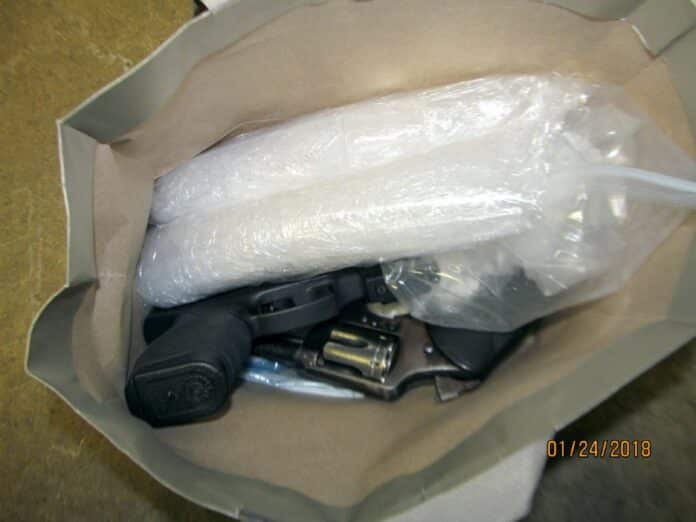
EDITOR’S NOTE: This is part two of a series detailing how local law enforcement and federal officials dismantled a drug cartel in Columbus focused on a particular family and that family’s associates. Named “Operation Columbus Day,” the investigation is believed to be the largest multi-agency drug investigation in Bartholomew County history.
A Columbus body shop on the east side of the city had become the focus of “Operation Columbus Day” by early 2019.
Local law enforcement shifted their attentions to a neighborhood south of State Street, where an informant had told them that individuals at a body shop there were living a double life and using the building for more than working on vehicles.
During the day, the body shop, located at 312 S. Mapleton St., was like any other in town, the informant told police, according to federal court filings. But in the evening hours, it turned into a drug distribution center where “large amounts of methamphetamine” were being sold.
Local law enforcement, along with the DEA and other agencies, had been investigating the distribution of methamphetamine in the Columbus area since early 2018 after an unusual spike in the local supply of the drug grabbed the attention of federal agents.
So far, all signs for the origin of the drugs had pointed to the West Coast and eventually Mexico.
Mexican cartels had taken over the U.S. methamphetamine trade in prior years, replacing the patchwork of “mom and pop” meth labs across the U.S. with clandestine, industrial-scale labs in Mexico, according to the federal Drug Enforcement Administration.
The cartels had since broadened distribution beyond major urban areas and were increasingly setting up shop in smaller, unsuspecting cities, according to the DEA.
And the end results were alarming — methamphetamine quickly became more potent, cheaper and more readily available on the street than ever.
“In this case, we noticed that large amounts of methamphetamine were flooding the Bartholomew County area in a short period of time,” said Michael Gannon, assistant special agent in charge at the DEA’s Indianapolis Field Office, which seized over a half-ton of methamphetamine in the state last year.
“And we were able to track some of the meth that was being seized (in the Columbus area) to Southern California and Mexico, and that’s what kind of led us to this investigation,” he said.
The investigation largely centered around Jorge Huberto Chavez — who investigators say “was one of the main guys” in the drug trafficking organization — and his family and associates, and would lead to about 60 arrests and the seizure of hundreds of pounds of drugs, more than $224,000 in cash and about 115 guns over a three-year period.
“For the city police and the sheriff’s office, we’ve never seen anything like this,” Bartholomew County Sheriff Matt Myers said at a press conference March 31.
In January 2018, police had closed in on Chavez, 38, and Jacklyn Munoz, 27, after intercepting a package containing 4 pounds of methamphetamine that had been shipped from California to a house at 3345 Westenedge Drive. The couple was later arrested after a police pursuit.
Other arrests soon followed.
Ivan Chavez-Lozaya, 28, was arrested in Columbus later that year on a warrant related to a probation violation stemming from a previous arrest for possession of methamphetamine, carrying a handgun without a license, driving while intoxicated and driving with a suspended license.
Not long after that, Bryan Miranda-Alvidrez, 23, was arrested in Columbus after selling nearly a quarter-pound of methamphetamine to a police informant over the course of a few days.
Gannon confirmed that these individuals were all part of a drug trafficking organization operating in Columbus, but wouldn’t say which Mexican drug cartel these individuals were tied to because the investigation is still ongoing.
However, Gannon said the Mexico-based Sinaloa Cartel and Cártel Jalisco Nueva Generación are responsible for the majority of drugs coming into central and southern Indiana.
“They’re the ones that are responsible for flooding Indiana with methamphetamine, as well as fentanyl,” Gannon said.
“What the Mexican cartels do is they dispatch people to certain parts of the United States,” Gannon added. “They have them assimilate into the various communities, and they will dispatch them with large quantities of drugs to their networks. At the end of the day, that’s exactly what happens in cases like this.”
Drug distribution, at night
The body shop at 312 S. Mapleton St. had popped up on law enforcement’s radar in February 2018, prompting authorities to investigate the distribution of illegal drugs in the area, according to federal court filings.
The 8,128-square-foot body shop, located on a 36,610-square-foot lot just south of the former Irwin Union Bank branch on State Street, was an eyesore of sorts then.
The were reports of piles of trash and waste from cars stored along the outside of the property, according to city records. Several oil barrels were later found to have possibly contaminated the soil.
The owner of the building, a local businessman, told police in 2018 that an individual named Juan Alberto Lopez-Mendez had been renting the building for six years based on a Mexican identification card Lopez-Mendez had provided him.
However, investigators later came to believe the tenant’s real name was Fernando Lopez-Mendez, a Mexican national they suspected could be involved in drug trafficking.
At least one person who would later be convicted on federal drug charges had been arrested in the vicinity of the body shop in the years leading up to the investigation, according to court records.
In 2017, Columbus police pulled over a black truck with no license plate traveling south on Mapleton Street. The truck crossed State Street and before being pulled over at the intersection of Pence Street and Vermont Avenue — a mere 500 feet from the body shop.
The driver was Miranda-Alvidrez, who told police that “he forgot to put a license plate on the truck, and was driving it across town to drop off the truck at his friend’s shop where it would be worked on,” according to a probable cause affidavit.
Miranda-Alvidrez initially told the officer that there were no weapons in the vehicle, but there turned out to be a loaded .357 revolver under the driver’s seat. Police also found a wad of about $2,000 in cash wrapped in rubber bands on him.
A police K9 detected the odor of narcotics, but police couldn’t locate any.
Under surveillance
In January 2019, law enforcement started conducting surveillance on the body shop, and within days made a big break in the investigation, according to federal court filings.
On Jan. 8, 2019, police observed a BMW with tinted windows pull up to the body shop, according to a probable cause affidavit.
A 39-year-old man with tattoos covering his neck, later identified as Federico Ernesto Reyes, 720 N. Marr Road, got out of the passenger side of the vehicle and went inside the shop.
He came back out a few minutes later and got back in the vehicle, which proceeded to drive north on South Mapleton Street.
After the vehicle turned onto State Street without signaling 200 feet before making the turn and allegedly committing other violations, Columbus police conducted a traffic stop, according to a probable cause affidavit.
The Bartholomew County Sheriff’s Office was called to the scene, where the late K9 officer Diesel alerted police to the odor of illegal narcotics.
Law enforcement agents searched the vehicle and found 31 grams of methamphetamine inside the glove compartment and underneath the passenger seat where Reyes was sitting.
Police then searched Reyes and found an additional 55 grams of methamphetamine and a digital scale, according to the affidavit.
Reyes was arrested and taken to Bartholomew County Jail on charges of possessing more than 28 grams of methamphetamine.
The next day, investigators obtained a warrant to search the body shop on Mapleton.
A look inside
Law enforcement agents raided the body shop the same day they got the warrant.
Once inside, they found at least six people, many of whom appeared to be living in rooms on the property that were being used as apartments, according to federal court filings.
In an office located on the first floor, authorities found a backpack containing several zip-lock bags, scales, a .32-caliber revolver and a bag of ammunition, as well as “a large amount of U.S. currency” inside a jacket.
They also found 489 grams of methamphetamine inside a cardboard box and an additional 170 grams of methamphetamine in a tackle box, with a total street value of about $30,000 at the time.
A semi-automatic handgun was found in a first-floor bedroom on the northeast side of the building.
Six people were arrested — Lopez-Mendez, 37; David Oswaldo Cornejo, 41; Mirna Benitez-Paz, 42; Isabel Benitez-Paz, 38; Michell Vasquez Benitez, 19; and Regelio Moreno Benitez, 19.
Photographs of the property taken by Columbus Code Enforcement shortly after the arrests show an assortment of objects — ranging from mattresses, shopping carts, automotive equipment and cases of Modelo Especial and Corona beer — strewn about, at times piled up nearly to the ceiling in several rooms, including rooms that resembled living areas.
In one room, black wires can be seen dangling from the ceiling in front of a wall that appears to be wrapped in turquoise plastic. Another room contained a wooden staircase with a broken step and large stereo speakers in front of a bright blue wall.
There also was a grimy kitchen with ply-board walls and ceiling tiles that appeared to have been taped together in some places.
The evening of the raid, police interviewed Lopez-Mendez with the help of a Spanish-language interpreter, according to federal court filings.
Lopez-Mendez told police that he played a role in a drug trafficking organization but did not personally distribute methamphetamine.
About two times per month, Lopez-Mendez continued, a Hispanic man known as “Mosquito” would travel from California to Columbus to stash methamphetamine in the body shop.
Mosquito would call Lopez-Mendez first before arriving a short time later.
“Upon arrival, ‘Mosquito’ would bring a box inside (the body shop) filled with approximately 2 to 4 pounds of methamphetamine at a time,” according to federal court filings. “‘Mosquito’ would then place the methamphetamine in various locations throughout the first floor office.”
Mosquito would pay Lopez-Mendez $2,000 to store the drugs, the court filing states.
Next steps
The federal charges came down swiftly.
On Feb. 14, 2018, Chavez and Munoz were indicted on charges of possessing with intent to distribute controlled substances, possessing a firearm in furtherance of a drug trafficking crime and possession of a firearm by a convicted felon.
Chavez pleaded guilty to the first two charges and was sentenced to 22.5 years in federal prison, according to federal court records.
Munoz pleaded guilty to possessing a controlled substance with intent to distribute and possessing a firearm in furtherance of a drug trafficking and was sentenced to nine years in federal prison.
Chavez-Lozaya pleaded guilty to possession of a firearm by a convicted felon on May 9, 2019 and was sentenced to five years, nine months in prison about three months later.
Miranda-Alvidrez was indicted on two counts of distributing 50 grams or more of methamphetamine on Sept. 17, 2019. He pleaded guilty to both counts and was sentenced to 10 years in prison.
Lopez-Mendez was charged with possession with intent to distribute 500 grams or more of methamphetamine, possession of firearms by a convicted felon and illegal reentry of a removed undocumented immigrants. He pleaded guilty to all three counts on Aug. 11, 2020 and was sentenced to 10 years in prison. Lopez-Mendez also is subject to deportation.
But these arrests are just the tip of the iceberg, according to federal authorities, who say they expect to release more information about the operation in the near future.
“I don’t think it’s common for Bartholomew County at all,” Gannon said of the surprising amount of drugs that were being trafficked out of Columbus. “And I think that’s why this was one of the most significant cases that’s ever happened there. And it was outstanding work that was done to get to that point.”
“It’s just incredible to get that stuff off the streets,” Gannon said.




